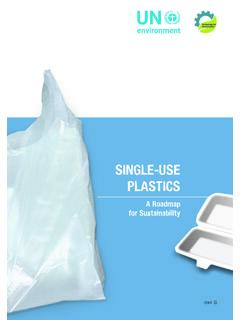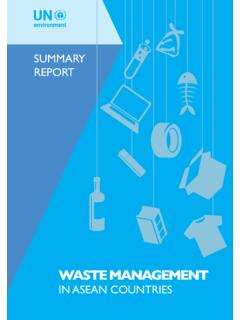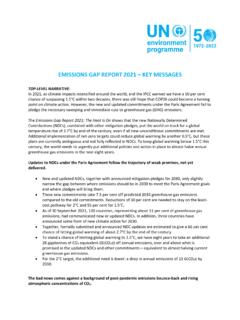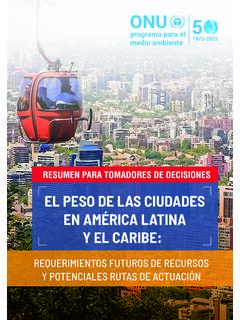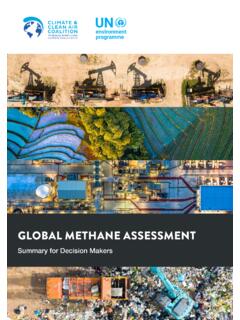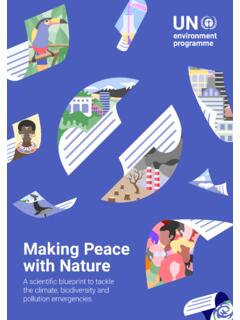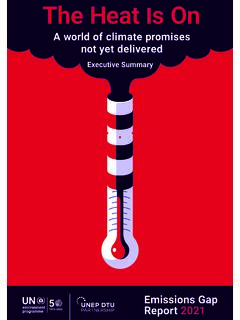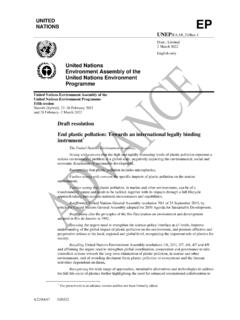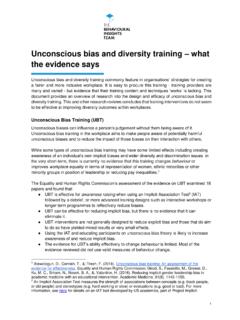Transcription of Greening the Blue Report 2021 - wedocs.unep.org
1 Greening the Blue Report 2021 The UN System s Environmental Footprint and Efforts to Reduce It 2021 United Nations Environment ProgrammeISBN: 978-92-807-3892-6 Job number: DTI/2390/GEThis publication may be reproduced in whole or in part and in any form for educational or non-profit services without special permission from the copyright holder, provided acknowledgement of the source is made. The United Nations Environment Programme would appreciate receiving a copy of any publication that uses this publication as a source. No use of this publication may be made for resale or any other commercial purpose whatsoever without prior permission in writing from the United Nations Environment Programme. Applications for such permission, with a statement of the purpose and extent of the reproduction, should be addressed to the Director, Communication Division, United Nations Environment Programme, P.
2 O. Box 30552, Nairobi 00100, Kenya. DisclaimersThe designations employed and the presentation of the material in this publication do not imply the expression of any opinion whatsoever on the part of the Secretariat of the United Nations concerning the legal status of any country, territory or city or area or its authorities, or concerning the delimitation of its frontiers or boundaries. Mention of a commercial company or product in this document does not imply endorsement by the United Nations Environment Programme or the authors. The use of information from this document for publicity or advertising is not permitted. Trademark names and symbols are used in an editorial fashion with no intention on infringement of trademark or copyright laws. The views expressed in this publication are those of the authors and do not necessarily reflect the views of the United Nations Environment Programme.
3 We regret any errors or omissions that may have been unwittingly made. Photos and illustrations as specified Suggested citation: United Nations Environment Programme (2021). Greening the Blue Report 2021: The UN System s Environmental Footprint and Efforts to Reduce it. Geneva. Production: Lizzy Burt, Graphic Designer URL of ContentsII. Executive SummaryUN Secretary-General QuoteIII. OverviewIV. Impact of COVID-19V. Greening the Blue TutorialI. Abbreviations and Acronyms54789101112131415161718353536373 8394042192021222324252629303233 Greenhouse Gas EmissionsUN Secretariat Greenhouse Gas EmissionsClimate NeutralityGreener Connections Through Virtual MeetingsWasteUNISFA s Commitment to the Environment Through Waste ManagementAir PollutionWFP Saving Lives, Changing Tackling Air PollutionWater and wastewaterUNHCR s Improved Water ManagementBiodiversityUNESCO Promotes Biodiversity and Urban Gardening in its Own PremisesGreenhouse Gas Emissions and Air Pollution Data Air Travel and the International Civil Aviation Organization (ICAO) Calculator MethodologyWaste MethodologyWater Methodology and Wastewater DataEnvironmental Governance, Procurement and Human Resources MethodologiesIX.
4 AcknowledgementsANNEX Environmental Performance DashboardEnvironmental GovernanceProcurementSustainable Procurement Criterion Used for FAO El Salvador Office RemodelHuman ResourcesRaising Staff Awareness: A one-UN quiz contest for World Environment Day 2020 Reporting CompletenessVI. Environmental ImpactsVII. Mainstreaming in Management Functions VIII. Methodology:4I. Abbreviations and AcronymsASR Annual Statistical ReportBRS Basel, Rotterdam and Stockholm ConventionsCBD Convention on Biological DiversityCDM Clean Development MechanismCEB The UN System Chief Executives Board for CoordinationCERs Certified Emission ReductionsCH4 MethaneCO2 carbon dioxideCTBTO Comprehensive Nuclear-Test-Ban Treaty OrganizationDOS Department of Operational SupportECA Economic Commission for AfricaECE Economic Commission for EuropeECLAC Economic Commission for Latin America and the CaribbeanEMS Environmental Management SystemEMG Environmental Management GroupESCAP Economic and Social Commission for Asia and the PacificESCWA Economic and Social Commission for Western Asiaeq equivalentFAO Food and Agriculture OrganizationFRIM Field Remote Infrastructure MonitoringGCF Green Climate FundGHG Greenhouse
5 Gas GWP Global warming potentialHFCs HydrofluorocarbonsHQ Headquarters IAEA International Atomic Energy AgencyICAO International Civil Aviation OrganizationICEC ICAO carbon emissions calculatorICT Green Information and Communication TechnologyIFAD International Fund for Agricultural DevelopmentIFC International Finance CorporationILO International Labour OrganizationIMF International Monetary FundIMO International Maritime OrganizationIOM International Organization for MigrationISO 14001 International standard for environmental management systems (EMS)ITC International Trade CentreITU International Telecommunication UnionITU-T International Telecommunication Union Standardization SectorKG kilograms kWh kilowatt-hourm3 cubic metreNGOs Non-Governmental Organisations N2O Nitrous OxideOCHA Office of the Pacific IslandsOHCHR Office of the United Nations High Commissioner for Human RightsOPCW Organisation for the Prohibition of Chemical WeaponsPFCs PerfluorochemicalsQR quick-responseREACT Rapid Environment and Climate Technical AssistanceSF6 Sulfur hexafluorideSUN Sustainable United Nations UN United NationsUNAIDS Joint United Nations Programme on HIV/AIDS UNCCD United Nations UNCDF United Nations Capital Development FundUNCTAD United Nations
6 Conference on Trade and DevelopmentUNDP United Nations Development ProgrammeUNEP United Nations Environment ProgrammeUNEP-WCMC World Conservation Monitoring CentreUNESCO United Nations Educational, Scientific and Cultural OrganizationUNFCCC United Nations Framework Convention on Climate ChangeUNFPA United Nations Population FundUN-Habitat United Nations Human Settlements ProgrammeUNHCR Office of the United Nations High Commissioner for RefugeesUNHQ United Nations HeadquartersUNICEF United Nations Children s FundUNIDO United Nations Industrial Development OrganizationUNITAR United Nations Institute for Training and ResearchUNOG United Nations Office at GenevaUNON United Nations Educational, Scientific & CulturalUNOPS United Nations Office for Project ServicesUNOV United Nations Office at ViennaUNRWA United Nations Relief and Works Agency for Palestine Refugees in the Near EastUNSSC United Nations System Staff CollegeUNU United Nations Volunteers programmeUNV United Nations Volunteers ProgrammeUN Women United Nations Entity for Gender Equality and the Empowerment of WomenUNWTO World Tourism OrganizationUPU Universal Postal UnionWFP World Food ProgrammeWHO World Health OrganizationWIPO World Intellectual Property OrganizationWMO World Meteorological OrganizationWMY Waste Management YardWSIS World Summit on the Information SocietyWTO World Trade OrganizationII.
7 Executive summaryIn 2007, the United Nations (UN) system embarked on a journey to integrate environmental sustainability in its facilities and operations. Since then, the United Nations Environment Programme (UNEP) annually collects and analyses the information provided by UN system entities on their environmental impacts and publishes this data in the Greening the Blue Report : the UN system s environmental footprint and efforts to reduce it. The Greening the Blue Report 2021 (hereafter the Report ) is purely disseminated in digital form and is composed of three elements: this PDF, entity webpages and data tables. This PDF focuses on the UN system-wide data, whereas entity-specific information is provided on the Environmental Performance Dashboard Annex, data tables and on each contributing entity s webpage.
8 The 2021 edition of the Report covers 2020 data. Updated criteria have been introduced in the 2021 edition of the Report to assess progress on environmental governance in line with the requirements of the Strategy for Sustainability Management in the United Nations System 2020 2030, Phase I: Environmental Sustainability in the Area of Management (hereafter the Strategy). As a result, only two entities have an environmental management system that meets the new requirements, while 13 are approaching the requirements. In 2020, the UN system generated ~ million tonnes CO2eq greenhouse gas (GHG) emissions, with per capita emissions of 5 tonnes CO2eq. The sources of the emissions were 32 per cent from air travel, 12 per cent from other travel (rail, road, sea, etc.) and 55 per cent from facilities. Better data collection allows this year to Report that, in 2020, 19 per cent of UN electricity worldwide came from the use of renewable energies either purchased from the country grid or self-generated.
9 The UN system was able to offset 99 per cent of of GHG emissions. The goal to achieve 100 per cent climate neutrality of its 2020 footprint was established in 2015 as part of the UN system s initial commitment to measure, reduce and, offset GHG emissions. While offsetting is an important factor in managing unavoidable emissions, the priority for the UN system remains emissions reductions and elimination. With significant worldwide travel restrictions and large portions of UN personnel working from home, the UN system generated approximately 25 per cent fewer GHG emissions than in 2019. The steep reduction in GHG emissions reflects the sudden and dramatic adaptations in operations that had to be made throughout 2020 as a result of the global COVID-19 pandemic. 5 The steep reduction in GHG emissions reflects the sudden and dramatic adaptations in operations that had to be made throughout 2020 as a result of the global COVID-19 pandemicThe required adaptations to UN operations due to COVID-19 also resulted in reductions in waste generation and water consumption.
10 Per capita waste generation for the whole UN system in 2020 was 396 kg/person. If Peacekeeping and Special Political Missions, which include personnel s living quarters and so have a higher waste generated average than other entities, are excluded from the total, the per capita is 184 kg. This is a reduction of 61 kg/person and 43 kg/person respectively from 2019. Water use also saw a reduction compared to 2019. In 2020, an average of 38 m3 of water was consumed per person by the UN system. In 2019, this average was 49 m3. COVID-19 radically changed the ways in which many UN entities work and engage with one another, with their personnel, member countries, companies and other organizations. As a result, much of the UN system s work moved online and the use of digital technologies became paramount to the continued delivery of the UN s mandate.
